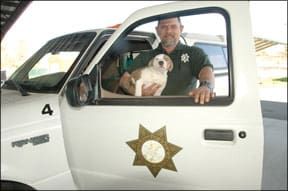[Updated August 24, 2018]
ANIMAL SHELTERS: OVERVIEW
1. Investigate your local dog shelters to determine their organizational structure and identify what services they offer.
2. Visit the shelters to determine the quality of services they offer and animal care they provide.
3. Support and help the shelters that support your patronage.
4. Take steps to improve the ones where humans and non-human clients receive less-than-optimal care.
Say the words “animal shelter” to 10 different people and you’re likely to get 10 different reactions – from a warm, happy smile to sadness and tears to anger. Why the disparity? Because shelters take the “no two alike” approach to service providing, and those 10 people likely had 10 very different shelter experiences. When you’ve had one experience with a shelter, good or bad, you might think all shelters are the same. You couldn’t be more wrong.
Many people think that shelters must all come under some national governing body that regulates what they do, a universal “mother club” like Red Cross, Boy Scouts, and Girl Scouts. In fact, the exact opposite is true – with a few rare exceptions, every shelter is its own entity, complete within itself, with its own policies and procedures, its own governing body, and its own list of services offered – or not offered.

Various Services Offered by Animal Shelters
There is a wide variety of services that may be offered by your local shelter, depending on their mission and vision as well as available resources. We provide a partial list of possible services below. If you see services on the list that you’d like your local shelter to provide, talk to your shelter’s administrators about the possibility. Be prepared to help find ways to fund the programs if funding isn’t already available!
– Housing of unwanted/homeless animals
– Rescuing animals in distress: trapped in chimneys or trees; victims of natural disasters; fallen off cliffs…
– Animal cruelty investigations
– Animal “nuisance” complaints
– In-house adoption program
– Adoption outreach programs
– Post-adoption follow-up and counseling
– Volunteer programs
– Education programs
– Spay/neuter assistance programs for animals belonging to the public
– Spay/neuter clinic
– Well-pet assistance: subsidizing routine preventative care such as vaccines, worming, etc.
– Veterinary care assistance
– Low-fee/affordable veterinary clinic
– Low-cost vaccinations, microchips, tattooing
-Off-leash dog park
-Special events
– Food bank/pet meals on wheels
– Companion animal training and behavior modification programs
– Animal-assisted therapy
– Reading programs (children reading to pets)
– Prison dog programs
– Euthanasia services
With a sole exception, national groups like the Humane Society of the United States (HSUS), the American Humane Association (AHA), Red Rover (formerly known as United Animal Nations), and the American Society for the Prevention of Cruelty to Animals (ASPCA) do little to dispel the confusion. None of these organizations has anything to do with the management of shelters around the country; they are primarily educational organizations, offering training, materials, and conferences at a price to local shelters, and issue-based information to the public. (The exception? The ASPCA does have a single shelter, in New York City.)
Some of these organizations have offices around the United States and sometimes the world; many are heavily involved in lawmaking, sometimes pursuing legislation whether local agencies support it or not. The organizations have no direct role in how shelters across the country are structured or run.
All of these groups offer paid memberships. Well-meaning animal lovers often join and support these national organizations, believing that donation dollars sent to those groups somehow find their way back to help animals in shelters in their own communities. They may be dumbfounded to discover that this is rarely the case. Oh, once in a great while, during a disaster or a high-profile cruelty case perhaps, but not to assist with the day-to-day costs of feeding and caring for sheltered animals. Rarely a penny.
Types of Animal Shelters
Although every shelter is unique, you can group them into similar types according to how they are structured:
Municipal Shelter
This type of shelter is owned and run by your government – city, county, township, parish – and is completely supported by tax dollars. It usually has a name like “Chattanooga Animal Services,” “San Francisco Animal Care and Control,” or “Multnomah County Animal Control.”
The shelter is part of the municipal “animal control” program, charged with protecting citizens from animals. They are usually responsible for enforcing city or county laws and regulations regarding animals; they may also investigate cases of animal cruelty, and sometimes offer education programs. Their enforcement staff may be called “animal control officers,” “animal services officers,” “dog wardens,” or some other such regulatory-sounding name.
“Animal Control” may be its own department in local government, or can function under the umbrella of the police department, department of public works, health department, department of parks and recreation, or some other division. Priority of services often depends on what department oversees its work. If it falls under the health department’s control, a high priority is placed on “rabies control” efforts; if it is under the control of the police department, enforcement of animal control laws may take center stage.
If you travel up the organizational tree you eventually reach a board of supervisors, a mayor, or whatever office is at the top of your particular governmental hierarchy.
Full-Service Private Nonprofit Shelter
As the name implies, this is a 501(c)3 not-for-profit organization with a Board of Directors and by-laws that govern the mission and policies of the group. Its mission is to protect animals from people, which often includes a strong educational component. When applying for nonprofit status, in most states these agencies are incorporated for the “prevention of cruelty to animals.” They may have members, and members may or may not have voting privileges.
These groups have names like “Marin Humane Society,” “Houston SPCA,” “Chicago Anti-Cruelty Society,” “Denver Dumb Friends League.” Same type of organization – different names. Just to emphasize the point, understand that “SPCAs” across the country have no affiliation with the ASPCA.
Full-service shelters, also called “open door” shelters, usually accept most if not all animals that owners bring to them, and may (or may not) also accept stray animals of all kinds. These shelters usually keep animals as long as they can. They have active adoption, education, and spay/neuter programs, and strive for low euthanasia rates, but can’t always succeed.
While the most diligent of these may be able to achieve a sometimes tenuous “low-kill” status, by choosing to accept all animals that are brought to them, most are compelled to regularly euthanize animals for a number of reasons. These reasons may include poor health or behavior, and space (at least some of the time, if not on a daily basis).
Full-service nonprofit shelters may also be involved in humane investigations, rescues, and cruelty case prosecutions. Cruelty enforcement workers are often given titles such as “humane officer” or “cruelty investigator.”
At the top of the nonprofit organizational chart is the president of the board, chair of the board, or other such title.
Full-Service Nonprofit Shelter with Animal Control Contract
Some full-service shelters contract with local community governments to perform the function of animal control alongside their humane society mission. Under this arrangement, the shelter is still governed by its board of directors, but must respond to the contracting government over issues related to the contracted services.
The contract may be only to house stray animals for a municipal animal control agency, or it may be to perform field enforcement services as well as sheltering. Law enforcement services involve issues such as animals running at large, barking, and other “nuisance” complaints, enforcement of licensing and “sanitation” (pooper scooper) laws, etc.
Nonprofit shelters sometimes take on government contracts for financial reasons; some rely on government dollars to survive. Others contract with a local government agency for humanitarian reasons, in the belief that a nonprofit shelter can do a better job of caring for the animals.
Some have dual motivations: they need financial support from local government and believe they can do a better job than government. But because the two missions can conflict – one emphasizes the protection of humans, the other emphasizes the protection of animals – this arrangement can have a deleterious effect on community support for the shelter. Actions such as issuing citations for leash-law violations, charging a fee for people to reclaim their impounded dogs, and declaring dogs “dangerous or potentially dangerous” don’t endear the organization to potential supporters. The issues are often no-win for the shelter; regardless of the action taken, someone will be unhappy.

Nonprofit shelters with government contracts usually euthanize greater numbers of animals, since they are compelled to accept all stray animals as defined by the contract. This group of animals is likely to include some of the least potentially adoptable animals in the community.
Limited Admission Nonprofit Shelter
Also a 501(c)3 tax-deductible organization with a “protect animals from people” mission, this type of shelter is sometimes called “selective intake,” “guaranteed adoption,” “low-kill,” or “no-kill.” Note: Animal lovers should never assume that so-called “no-kill” shelters are the most praiseworthy, or provide the kindest care to their wards. Please see “What’s Wrong With No-Kill?” from this issue.
Also governed by a board of directors, this shelter limits the number of animals selected, usually with some kind of screening test for potential adoptability. There may be a long waiting list to place a dog or cat in one of these shelters, as the responsible ones only accept a new animal when kennel space opens up. Their low-kill or no-kill policies may mean that some animal companions occupy kennel space for many months – or even years.
Animal Rescue Groups
These may or may not be 501(c)3 not-for-profit organizations, and they may or may not be so-called “no-kill.” Some rescue groups have an actual shelter; some house their dogs in foster homes and at boarding kennels.
Breed rescue groups that operate under the auspices of their breed clubs are usually not-for-profit with a governing board of directors. They are often realistic about euthanizing dogs who aren’t good adoption prospects – although not always. They tend to use scarce resources wisely, and make thoughtful and difficult decisions about how to help the most number of dogs with those limited resources.
Non-breed-affiliated rescues and mixed-breed rescues can run the gamut from 501(c)3 legitimate nonprofit rescues to private adoption agencies to hoarders that pass as rescues.
Measuring Your Local Dog Shelter Up to Size
Within each category, there are outstanding shelters and horrible ones. Quality of animal care doesn’t depend on a big budget – the basics of feeding animals, cleaning the cages and kennels, and keeping a shelter grounds uncluttered and tidy are within the budget of any legitimate shelter. Do you know how the shelter(s) in your community measure up? Here’s how to find out:
• Identify the type of organization. This information will help you understand how and why they do what they do, and how to best interact with them.
• Go to its website. Many shelters these days have a comprehensive Internet presence, and you can find a lot about an organization – or at least what it says about itself, by visiting its site.
• Visit each shelter. Keep your eyes, nose, and ears wide open. Do you see dirt, clutter, and lots of hazardous conditions, or are the facilities clean, reasonably odor-free, and well-maintained? Deferred maintenance could be a function of budgetary shortfalls but cleaning should not be short-changed.
• Watch customer service interactions. Are the staff members polite and helpful, even in emotionally charged situations and with overwrought clients? Or are they abrupt, rude, and disrespectful? Courtesy costs nothing, and there’s no excuse for rude shelter staff.
• Observe the animals in the kennels. Do they seem reasonably well-adjusted in the admittedly stressful environment of any shelter, even the best ones? Do they enjoy environmental enrichment, such as having beds in kennels, stuffed Kongs, toys, outside play areas, and opportunities to go for walks? Or do you see barrier aggression, obsessive/compulsive spinning, depression, and self-mutilation?
• Evaluate the population density. Are there one or two dogs per kennel, or 15? Do puppies and kittens have appropriate playmates? Do kennel-mates get along well, or are some intimidated by others?
• Find out what services they offer, then utilize their services. Walk through their adoption process. (Heck, you could even adopt a shelter dog!) Call for help with a stray dog, an animal in distress, or a neighborhood animal dispute.
• Become a volunteer. You’ll learn more about the behind-the-scenes operation of the shelter if you’re part of the scene. If you can’t handle being in the shelter frequently, volunteer in some other area, such as public relations, fundraising, education, or putting on special events. Suspend judgment for at least the first six months. If you come in like gangbusters, telling everyone how to improve, you’ll lose trust and credibility. Walk many miles in their shoes first.
• Ride along with an officer. Spending time with an officer in the field is a major eye-opener, guaranteed to give you a whole new perspective on the challenges of the animal protection profession.
• Watch the news and search the archives. Does your shelter regularly appear in the media or in your local newspaper’s letters to the editor? Are the stories and letters positive or negative? Go back in recent history (five to 10 years) to see what issues and challenges the shelter has faced in the not-too distant past, and how well they handled them.
You Can Make a Difference
When you’ve completed your investigation, you have several options. You can focus on the best shelter in your area and give it your support. Make an appointment to meet with the top administrator (executive director, not board president or city administrator) or her designee, and discuss your findings. Be positive! Start by praising all the great things you found out about the shelter. Then express your understanding and empathy for the difficult challenges almost every shelter faces: funding shortages, staff turnover, community conflicts . . . and ask how you can help. Then do.
As you gain the respect and trust of shelter staff and administrators, you can truly be effective in making the good shelter even better. Be sure to express your support with your checkbook as well, or even in your will.
Another option is to turn your attentions to one or more of the less well-run shelters and do the same. If they’re open to your interest and desire to help, work with them. If they’re not receptive to your advances, move up the organizational ladder until you find someone who is, and work from there. You can help draw community attention to the problems in a positive way, and aid in finding solutions.
If your advances are met with stone walls and silence, you may need to take stronger action, particularly if animals are suffering as a result. Document your concerns by writing letters – and keep copies for your own files. Perhaps more stridency with the powers-that-be can shake something loose. If necessary, promise to go to the media – and then do – and gather community support to pressure for change. If the shelter is a municipal shelter, remember that your elected officials are ultimately responsible for seeing that the right thing gets done – and you are a voter.
If you discover a hoarder posing as a rescuer, insist on enforcement action. Your research should have already informed you as to which agency in your community does cruelty investigations. Go to the head of the investigations department and present any evidence you have regarding the situation. Know that you may be called upon to testify in court if the agency isn’t able to resolve the situation more gently.
Don’t be swayed by the tears or protests of the hoarder/rescuer who professes to “love” her animals. They all say that. And she probably does love them. That doesn’t change the fact that animals suffer and die under her loving care – or lack thereof.
If the agency is reluctant to diligently pursue an investigation, climb the ladder to the top of the organization and the media, if necessary. The animals are counting on those who care, and who are brave enough and strong enough to take action.







This us a very good overview of shelters. I am delighted to see the exposure of several so called shelters that sound legitimate and do nothing for the animals but whose executives have extremely high salaries. PETA is another group that does very little for the animals. They attend an emergency, get publicity and leave. If they do take some animals with them, they are killed later on. They have no facilities but they have millions and millions of dollars for self promotion and to encourage donations from unsuspecting people but the money only goes into their own coffers.. The other exposed groups are listed Humane Society of the United States (HSUS), the American Humane Association (AHA), Red Rover (formerly known as United Animal Nations), and the American Society for the Prevention of Cruelty to Animals (ASPCA) There are also some very cruel municipal shelters that allow the animals to suffer dreadfully from injuries and do nothing to help. They will sell dangerous dogs to new adopters that have been brought in for biting and the cycle continues. The animal bites, can do serious damage, is brought back to the shelter and is adopted out again. There is so much more to say but this piece does a great job of telling it like it is.
I adopted many dogs from breed shelters run strictly by selfless, hard working volunteers. The shelters live or die and survive solely on individual donations. They are always begging for money and I know exactly where my money goes.
Well said!
Thank you so much for this confirmation. I get a slug of material from like ASPCA and do not finite. My local SPCA group and several fostering groups get my vote. I even stopped supporting one seemly legitimate shelter when they were overwhelmingly rude to someone I sent there about a small 11year old dog who badly needed a good home for his last years. She came out devastated and empty handed! Nothing’s perfect but we have to try to support what we can.
I would like to know how you all feel about North Shore Animal League (located in Nassau County, New York). They do a ton of publicity and have a ton of money yet never actually do anything to help the local rescue groups. Where does NSAL fall into any of these categories? Thank you.
Several of the animal control offices in the local towns have recently started to take on shelter functions of adopting out stray pets that are not claimed. Some also attempt to place pets in foster homes until they are adopted. The municipality has to make a real commitment for this to work, because providing long-term housing and care of these pets is expensive even with donations and volunteers. Those dogs that remain kenneled until adopted often have behavioral issues because they don’t get enough exercise and individual attention in the kennel situation. Then there are the ones that have serious medical issues and eat up dollars and staff time with treatment. Keeping a pet alive and giving it a real quality life are two different things. I think euthanasia is better than just keeping it alive.